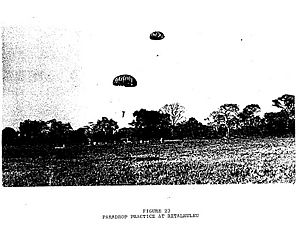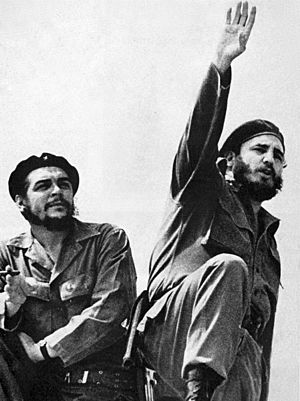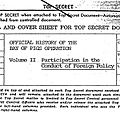Bay of Pigs Invasion facts for kids
Quick facts for kids Bay of Pigs Invasion |
|||||||
|---|---|---|---|---|---|---|---|
| Part of the Cold War | |||||||
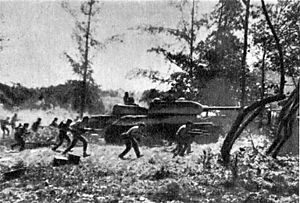 Cuban soldiers supported by T-34 tanks attacking near Playa Giron. April 19, 1961 |
|||||||
|
|||||||
| Belligerents | |||||||
| Commanders and leaders | |||||||
| Units involved | |||||||
National Revolutionary Militia |
|||||||
| Strength | |||||||
8 American B-26 bombers 5 supply ships |
|||||||
| Casualties and losses | |||||||
| Cuban Army: 176 killed 500+ wounded Militia: 2,000 killed and wounded |
Brigade 2506: 118 killed 360 wounded 1,202 captured United States: 4 killed 2 B-26 bombers shot down 2 supply ships lost |
||||||
The Bay of Pigs Invasion was a secret plan in 1961 to remove Fidel Castro from power in Cuba. This happened during the Cold War, a time of tension between the United States and the Soviet Union. The CIA of the United States trained a group of Cuban exiles. These exiles then launched an attack on Cuba at a place called the Bay of Pigs.
The invasion was a big failure. Most of the attackers were captured or killed. Several problems led to this failure. These included a lack of promised air support and a last-minute change in the landing spot. This event was one of many attempts by the CIA to try and change the government in Cuba.
Contents
Planning the Bay of Pigs Invasion
The CIA started getting ready for this mission during the Eisenhower presidency. They began training Cuban exiles many months before the United States stopped official relations with Cuba in January 1961. Tensions between Washington and Havana were growing at this time.
The CIA felt confident they could overthrow Castro. They had helped remove other foreign leaders before. For example, they helped in Iran in 1953 and Guatemala in 1954.
The first plan was to land the exile group, known as Brigade 2506, near the old city of Trinidad, Cuba. This city is about 400 km southeast of Havana. It is located near the Escambray mountains. This location offered many good options for the invaders.
However, President John F. Kennedy changed important details of the plan. He ordered the landing area for Brigade 2506 to be moved. The new spots were in Matanzas Province, about 202 km southeast of Havana. These were on the eastern edge of the Zapata peninsula at the Bahia de Cochinos (Bay of Pigs). The landings were set for Girón and Larga beaches.
The Invasion Begins
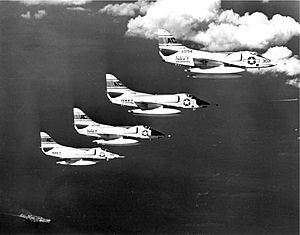
On the morning of April 15, 1961, three planes with Cuban markings bombed Cuban airfields. The goal was to destroy Cuba's air force. This would give Brigade 2506 control of the skies before their landing. But this plan failed. The airstrikes were not continued as planned. Also, Castro already knew about the invasion. He had moved his planes to safety.
By mid-morning, almost all the bombers from the Brigade were flying back. They were heading to their base in Nicaragua to refuel and re-arm. But when they landed, they received a message from Washington. It ordered them to stop all future combat flights over Cuba.
About 30 paratroopers were dropped into the area. However, their equipment was lost in the swamps. The troops also failed to block the roads. This allowed the Cuban government to send more soldiers to fight the invasion.
On April 17, about 1,500 exiles landed on Cuba's southern coast. They were armed with weapons from the United States. They hoped local people would support them. They planned to cross the island to Havana. The CIA thought the invasion would cause a popular uprising against Castro.
However, Castro already expected the operation. He had gathered many Cubans who were against him. About 100,000 people were rounded up, with 20,000 in Havana alone. By the time the invasion started, these people were held captive.
Cuban forces at the landing site quickly surrendered. But it soon became clear that the exiles would not get enough support. They were likely to lose the fight. President Kennedy decided not to send US air support. This support might have helped the invaders. Even though U.S. Marines were on ships nearby, they were not sent in.
Aftermath and Casualties
The fighting ended on April 19. One hundred and fourteen exiles were killed. The rest were captured. The number of Cuban forces killed varies by source. However, it is generally believed to be much higher.
The 1,189 captured exiles were quickly put on trial. A few were executed. The others were sentenced to thirty years in prison for treason. After 20 months of talks with the United States, Cuba released the exiles.
Some people believe that Cuba's losses during the Bay of Pigs Invasion were very high. Some reports suggest over 2,200 casualties.
Interesting Facts About the Bay of Pigs
- The United States CIA trained the Cuban exiles.
- The Cuban exile invasion force was called Brigade 2506. They were defeated in just two days. 114 of them died.
- After the defeat, President Kennedy said he doubted his presidency could survive another disaster like that.
- The failed invasion actually made Fidel Castro's communist government stronger.
- The Russians, who were Cuba's main ally, knew about the invasion before it happened. The CIA knew this but went ahead with the invasion anyway.
- 1,200 members of Brigade 2506 surrendered and were taken prisoner.
- 20 months later, the Americans made a deal with Fidel Castro. They traded $53 million worth of baby food and medicine to get the prisoners released.
Related Pages
Images for kids
-
Douglas A-26 Invader "B-26" bomber aircraft disguised as a Cuban model
-
Bahia de Cochinos 1961
-
The Bay of Pigs Memorial in Little Havana, Miami
See also
 In Spanish: Invasión de bahía de Cochinos para niños
In Spanish: Invasión de bahía de Cochinos para niños


